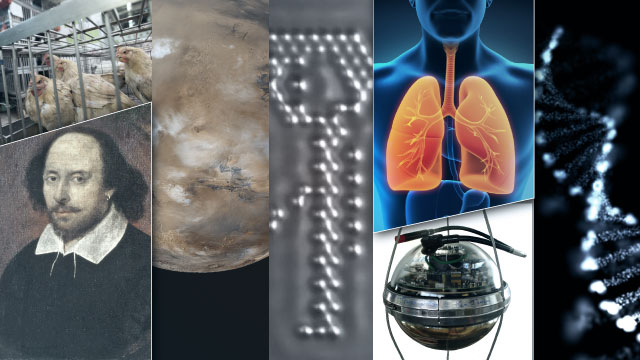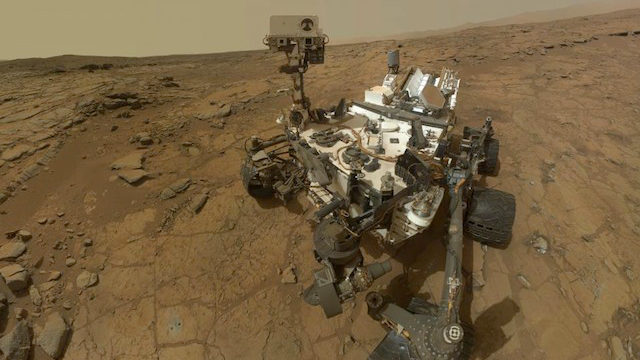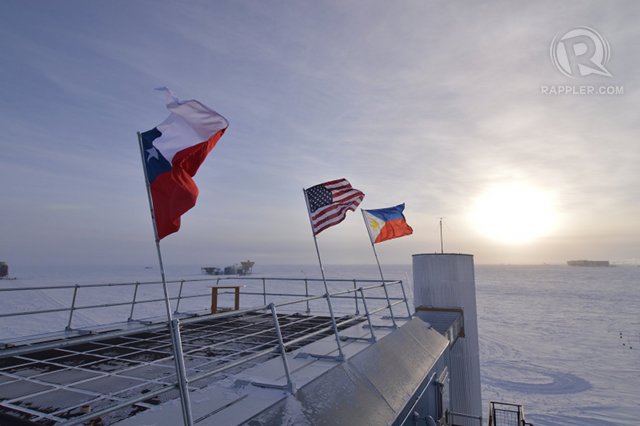SUMMARY
This is AI generated summarization, which may have errors. For context, always refer to the full article.

MANILA, Philippines – 2013 was another exciting year for science: interesting discoveries were made by scientists (and even non-scientists!) in various disciplines across the world.
With countless discoveries and stories, what were the most interesting and groundbreaking? To help us, we asked the Mind Movers – a.k.a. the resident scientists – of The Mind Museum in Taguig, the country’s leading museum dedicated to science, about what they think are the most top stories in the world of science this year.
Let’s take a look at what they listed as the year’s top science stories.
1. Shakespeare in DNA.
In January 2013, researchers from the European Bioinformatics Institute (EBI) were able to store all of Shakespeare’s 154 sonnets, totaling 739 kilobytes, in DNA.
DNA has 4 letters of a chemical alphabet: A, C, T, and G. One standard alphabet letter represented in binary consumes 8 binary digits or “bits.” In the DNA language used by the researchers, they encoded one standard alphabet letter into one group of five chemical letters. This method of encoding is able to account for all the diversity necessary to store all the characters needed for data—ranging from plain text to even entire programs. The storing technology developed by the scientists is quite dense, with a sonnet being contained in just 0.3 millionths of a millionth of a gram. The scientists say that one gram of DNA could contain more information than a million CDs (each CD contains 700 million bytes).
Storing information in DNA is a relatively trivial task, however, since molecular biology labs routinely design short strings of DNA. There have also been many previous successful trials at storing digital information in DNA. Nevertheless, what distinguishes the research of the EBI is the efficiency of the retrieval of the information. After reconstructing the data, the researchers found zero errors. The researchers also claim that their technology can be scaled to even greater amounts of data. – Garrick Bercero
2. Martian Water.
The year 2013 has been a landmark in discoveries about water on Mars. Within a few months of landing on the Martian surface last year, NASA’s “robot geologist” Curiosity began scooping dirt from the red planet’s surface and analyzing the dust for signs of water. In September of this year, NASA scientists astonished the world when they released the results of Curiosity’s investigation, announcing that the red planet’s dust surface is 2% water by mass. This means that every 100 g of Martian dust contains about 2 g of water. This was quickly followed by the announcement that a part of Gale Crater, the crater Curiosity was roaming in, might have held a lake of liquid water millions of years ago back when Mars’s climate was very different from what it is today.

To serve as the cherry on top of this ice cream of discoveries, a study was published this December suggesting that there might still be a lot of liquid water on Mars today. The said study suggests that certain changing features on the planet’s surface implies that material is probably being moved by large amounts of flowing water. Because water is thought to be an important ingredient in the formation of life as we know it, all of these findings have massive implications on the search for life on Mars. This search, whether for extinct or extant living organisms, continues, but the discovery of water on the red planet would provide us powerful leads to aid us in that search. – Pecier Decierdo
3. Scientists Produce “A Boy and His Atom”.
The smallest film was produced by IBM scientists by manipulating carbon monoxide molecules on a copper plate, and then viewing them using a Scanning Tunneling Electron Microscope.
It’s a story of a boy playing, dancing and bouncing with his friend, the atom. STM operates at 5 K, where at this temperature, molecular motion is extremely limited. The temperature forces the carbon monoxide molecule to remain in place with the copper substrate. Manipulation of the needle in the STM allows for manipulation of the position of the carbon monoxide molecule. Still images are taken to create the film, with a frame of 45 by 25 nm. The story stands out because it is the world’s first smallest movie. – Hannsen Tan
4. Scientists Investigate and Contain H7N9 Virus.
In March 2013, an epidemic of a new influenza A virus (H7N9) broke out in Shanghai and Anhui Province in China, with a total of 63 confirmed cases – 14 of these proved to be fatal. Virologist Chen Hualan and her team of scientists then quickly sought to identify and characterize the viral strain that caused it, before it led to a worse epidemic. When the researchers sequenced the genomes of the viruses, they found that the viruses from the poultry markets were 99.1%-99.9% homologous with the viruses isolated from humans.

Poor hygiene in retail markets also increases the chances of passing the virus onto humans: birds are slaughtered and de-feathered by machines, launching bioaerosols into close proximity with unknowing customers. Once the researchers knew what they were dealing with, China’s Ministry of Agriculture and other institutions promptly worked together to track down the source of the virus and how it was transmitted. Once they narrowed down the origin of the virus to the poultry markets, these were shut down, effectively decreasing the number of cases by a dramatic rate. This is a good example of how quick and efficient control measures can prevent an epidemic from increasing in scale. – Erin Mercado
5. Discovery of ‘Teen Gene’ Could Hold Promise for Combating Severe Mental Illnesses.
Symptoms of mental disorders such as schizophrenia, depression and drug addiction are often observed and reported during adolescence. Researchers have recently isolated the “teen gene” that could tell determine the vulnerability of the brain’s development to these psychiatric disorders.
According to the researchers at the McGill University-affiliated Douglas Institute Research Centre, the gene DCC is responsible for dopamine (DA) connectivity in the medial prefrontal cortex (mPFC). Dopamine is a neurotransmitter involved in reward-related behavior; while the prefrontal cortex, which is the area of the brain associated with behavior, judgment and decision-making process, continues to develop until adulthood and is therefore highly susceptible to stressors in adolescent life experience.
The researchers worked with mice models and examined DCC expression on human subjects as well – specifically in postmortem brains of people who committed suicide. DCC expression was approximately 48% higher compared to control subjects.
This breakthrough discovery serves as another piece to the many puzzles about mental disorders giving us insight into the susceptibility of brain development during the adolescent stage. The study suggests that “…the DCC gene can be altered by experiences during adolescence”. Moreover, the research can expand and target new developments for social and pharmacological therapies. – Carlie Dario
6. Gold-plated Nanoparticles Seek and Destroy Cancer Cells.
Scientists from Cornell University developed a nanoparticle plated with gold to seek and destroy cancer cells. Being likened to the US Navy SEALs, these gold-plated nanoparticles have antibody guides to steer them through the bloodstream towards the cancer cells which will then be heated using infrared. This method may revolutionize the fight against cancer.
Some techniques in killing cancer cells involve the use of radiation and chemicals to kill cancer cells. A less common method is called thermal therapy or thermotherapy which heats body tissues to kill cells. However, these kinds of treatments also kills healthy cells. The use of “targeted” methods such as nanoparticles may reduce the risk of killing healthy non-cancer cells.
The process showed a significant reduction in tumor cells within 30 days but not a complete reduction. But this would increase the likelihood of success of other aggressive methods in curing cancer. – Art Galapon
7. Using “IceCube” to observe particles from space.
Scientists from the IceCube project have been awarded as “2013 Breakthrough of the year” for being the first to observe high-energy cosmic neutrinos. Neutrinos also made news last year as they were thought to have traveled faster than light. It was later proven to be an error. Now, it again makes news for another interesting reason.
We have been probing space with the aid of telescopes capturing light that has travelled very long distances from within and outside our galaxy. Light is made up of particles called photons which interact with matter and thus slow down on their way to earth. Neutrinos on the other hand do not interact with matter in the same way. It can slip through dusts, planets and other massive objects in space so it arrives earlier than light and thus appears to be faster than it.
Using this fact, scientists built a telescope not directed towards the sky but downwards, facing the earth. The project called IceCube has been doing so and it is located in antarctica where massive areas of ice are available to build the downward-looking telescope. When neutrinos hit an atom, a muon is produced. When a muon passes through a clear material like ice, it leaves faint blue trail of light which is called Cherenkov radiation. The IceCube telescope which is buried 2,820 m under the ice (around 9 times longer than the Eiffel tower), was designed to detect that trail of light and tell us more where about the neutrino that made it – like where it came from and how energetic it is.
University of Toronto physicist and IceCube collaborator said that the result of the experiment marks “a new era in astronomy”. There are a lot more things in space which cannot be unveiled by what we can see alone. He adds that “This result opens up the ability to use neutrinos to explore our universe. These really are the ideal messenger particles since they can travel vast distances without stopping or slowing.” – Uzzie Perez
8. “Using” HIV to fight cancer.
All around the world, cancer and HIV cases persist and resist, but scientists are making headway in using both one disease to combat the other. In a video of a study popularized this year called “Fire with Fire” has potential in using what they know about HIV come up with cancer therapy. One of the major forms of cancer in Filipino children is leukemia, a type of cancer originating in the bone marrow – the major factory that produces blood. In the blood of someone with leukemia, there are B cells also known as Bone Marrow Lymphocytes that are already very sick with cancer cells. On the other hand, its sister lymphocytes known as T cells that “grew up” in the thymus (hence the name T cells) and can be genetically modified to help destroy cancer cells found in the bone marrow.
T cells are responsible for self-mediated immunity in the body and it is also the pathway that viruses like HIV can tap into T cells. By tapping into T cells, scientists are able to plant chimeric antigen receptors (CAR) to produce coined term Serial Killer Cells, also known as CAR T cells that specifically target chronic lymphocytic leukemia via CD19, a very attractive tumor target. A useful fact about T cells is that it has memory cells which keep tabs on viruses, bacterial infections, and previous illnesses one has had in order to attack it if ever it emerges in the immune system again. This may prove itself useful since cancer can easily spread, and may therefore be detected earlier by T cells in the future. – Asia Urquico
9. Knowing the Knee.
August this year, doctors from UZ Leuven in Belgium have just made the first full anatomical description of a ligament in the human knee. Though first noted by Dr. Paul Segond in 1879, a team of researchers led by Steven Claes were the first to fully document the function of the structure. Named the anterolateral ligament (ALL), the ligament was seen to be present in 97% of the cadavers dissected during the study. The detailed documentation of this new organ may shed insight on knee instability, which is usually caused by injuries to the anterior crucial ligament (or ACL). This story is fascinating, as it shows that though we know so much about the human body and have achieved a lot in the fields of science, there is still so much more that can be discovered, and that there are always questions that needs answers in science. – Will Rozee
10. New Lungs.
Following the success of organ engineering for heart, liver, kidney, and pancreatic cells – to name a few, researchers have figured out a way to generate lung or airway cells.
Transplantation has been around the medical arena for quite some time but the lack of compatible organ donors has been an equally challenging factor. Scientists have found a way to utilize human induced pluripotent stem (iPS) cells, similar to human ES cells, but derived from adult lung skin cells programmed “backwards” to simulate embryonic stem cells. Though past studies have created lung cells, this recent discovery has generated six (6) types of lung and airway cells including what we call Type II Alveolar Lung Cells, functional cells that are able to uptake and produce surfactants, a type of protein important in the maintenance and integrity of alveoli, a lung structure that is the site for gas exchange.
The implications for these new advances in regenerative medicine have uplifted the hopes of modelling lung diseases – especially those that involve the skin cells that line the lungs, testing drugs, and ultimately, creating new lung organs for more successful transplants. – Artha Ting
11.The Biggest Viruses Discovered.
The team of Dr. Claverie of Aix-Marseille University in France recently discovered the biggest viruses ever seen on Earth- the Pandoraviruses. They found the viruses from sediment samples obtained off the coast of Chile and in an Australian pond. Unlike other viruses that generally measures 50-100 nm, pandoraviruses are about a micron in length – comparable to the size of bacteria and even bigger than some eukaryotic cells! These viruses are so large that they can be seen under light microscopes whereas electron microscopes are necessary to view the familiar viruses. The common viruses are those that causes human diseases but pandoraviruses do not seem to pose a threat to humans.
According to articles, this discovery raises questions on the current 3-domain classification of life, since 93% of their genes cannot be traced back to any known lineage up to present. It is possible that they may represent another branch of life distinct from the three domains – archaea, bacteria, eukarya. However, it must first be taken into account whether viruses are to be considered as living or not. Some scientists also believed that these viruses could probably come from other planets such as Mars, which is interesting since if proven, it could be another evidence of life in Mars. – Meg Daupan
12. Patent on genes invalidated by the US Supreme Court.
Since the human genome was completed in 1990, many companies have been on a race to find a gene/s for this and that disease and filed for patents for them. An example would be the BRCA 1 and BRCA 2 genes which seriously raises your risk of breast cancer if you had them. Myriad Genetics filed a patent for those genes. This year, the US Supreme Court, in a decision hailed by most in the scientific community and the public as a triumph for all, invalidated those patents citing that no one can file a patent for what occurs naturally. This means that so far, good or bad, you still own your own genes. – Maria Isabel Garcia
How about you – what are your top science stories, innovations and discoveries for 2013? Leave a comment below! – Rappler.com
Image collage by Matt Hebrona. Photos via EPA, Wikimedia Commons, www.discovery.com and Shutterstock (1,2)
Add a comment
How does this make you feel?

There are no comments yet. Add your comment to start the conversation.